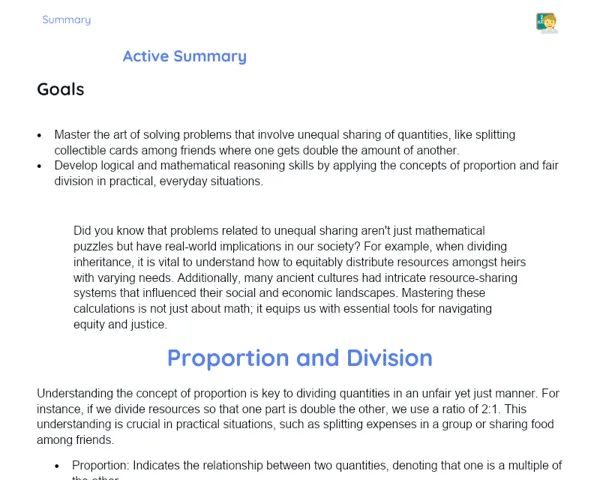Summary Tradisional | Representation and Reading of Research
Contextualization
In our daily lives, whether at a local kirana store or in a classroom, we often come across information displayed in graphs and tables. For example, while shopping, you might see charts showing which products are most popular, and in schools, graphs can help us visualise student performance across different subjects. Being able to read and understand these visual aids is crucial for making sense of the world around us.
Graphs and tables are used in almost every field—from forecasting the weather, monitoring public health, to analysing statistics in sports and even gaming. For instance, scientists rely on graphs to observe changes in the climate over the years, while doctors monitor patients’ progress using similar tools. A good grasp of these representations not only supports informed decision-making but also enhances our overall understanding of everyday data.
To Remember!
Simple Bar Graphs
Simple bar graphs serve as handy visual aids that allow us to compare quantities across various categories easily. In these graphs, each bar stands for a specific category, and its height reflects the relative quantity or value linked to that category. Such graphs are especially useful when you need to quickly spot which categories have more or less data.
To create a simple bar graph, the first step is to collect your data. Once you have the data, organise it into the required categories, with each category corresponding to a bar. The bar’s height is determined by the numeric value associated with that category. For example, if you are representing fruit sales, each bar could represent a different type of fruit, and its height would indicate the quantity sold.
One of the key benefits of simple bar graphs is that they are easy to read and interpret, enabling one to immediately discern which categories have higher or lower values. This simplicity makes them popular in business, education, and scientific research as a tool for presenting information clearly.
When reading a simple bar graph, it is important to note the axes: the horizontal axis (x) commonly represents the different categories, while the vertical axis (y) shows the numeric values. Also, the graph’s title and the labels on both axes help in fully understanding the information being presented.
-
Each bar represents a particular category.
-
The height of the bar indicates the corresponding quantity or value.
-
They are straightforward to read and interpret.
-
Attention to the axes, title, and labels is important to grasp the full picture.
Tables
Tables are neatly organised frameworks consisting of rows and columns which help in presenting data in a systematic and clear manner. In a table, each row usually represents an item or a category, while each column shows a particular feature or quantity linked to that item or category. This format is commonly used to efficiently organise and compare large amounts of data across multiple fields.
To create a table, one must first gather the relevant data and then arrange it logically. For instance, if you are tracking the sales of different fruits, each row could represent a type of fruit, and the columns might indicate the quantities sold on various days of the week. This method of organisation makes it simple to compare different items and understand their respective details.
A well-structured table makes it easier to read and interpret data quickly. Clear and descriptive titles for both columns and rows are essential so that one can immediately understand what each section represents. Moreover, this layout helps in conveniently identifying patterns and trends in the data.
-
Neatly organised in rows and columns.
-
Each row represents a specific item or category.
-
Each column indicates a characteristic or quantity related to the row.
-
Column and row titles are key to effective understanding.
Elements of a Graph
Every graph comprises several key elements that are vital for correctly interpreting the data it presents. The main elements include the title, the axes (both x and y), the labels for various categories, and the values shown by the bars or lines. Each element has its own role in ensuring that the information is communicated clearly and effectively.
The title of the graph provides an immediate idea of what is being depicted. It should be clear and descriptive, signalling the overall theme or question addressed by the graph. For example, a title like 'Fruit Sales per Week' immediately tells us that the graph highlights the sales figures for fruits over a week.
The axes form the backbone of the graph. The horizontal axis (x) generally represents different categories, while the vertical axis (y) shows the numerical values. Labels on the x-axis and the values on the y-axis are crucial for understanding which category each bar or point corresponds to. In addition, the labels on the bars help prevent any confusion by clarifying exactly what each bar stands for.
-
A clear and descriptive title.
-
The x and y axes indicate categories and their corresponding values.
-
Labels on the graph are essential for clarity.
-
The height or length of the bars/lines represents the magnitude of the data.
Data Interpretation
Data interpretation is the process of analysing and making sense of the information presented in graphs and tables. This involves closely examining various elements—such as the height of bars in a graph or the arrangement of data in a table—and understanding what the data is trying to communicate. This skill is essential for making informed decisions and enhances our grasp of the subjects we deal with daily.
When interpreting a simple bar graph, one should look at the height of each bar, which tells us the quantity or the relative value of the data represented by that bar. Comparing the heights of different bars can help highlight which categories have higher or lower values. In addition, it is important to take note of the labels and the y-axis values to obtain a complete picture of the information.
Similarly, for tables, start by carefully reading the titles of the columns and rows to determine what each section represents. Then, compare the entries to identify trends or patterns in the data. This methodical approach can significantly improve your understanding of the subject matter.
Ultimately, effective data interpretation also involves questioning the data. For instance, while examining a bar graph on fruit sales, ask yourself which fruit sold the most, which sold the least, and what might be the reasons for these differences. Such questions foster a deeper understanding of the data and help extract meaningful insights.
-
Analyse and understand the information given.
-
Observe the bar heights in simple bar graphs to gauge values.
-
Check column and row titles carefully when reading tables.
-
Ask probing questions to deepen your understanding of the data.
Key Terms
-
Simple Bar Graphs: Visual aids for comparing quantities across different categories.
-
Tables: Neatly organised arrays of rows and columns used to present data in a systematic manner.
-
Elements of a Graph: Fundamental components such as the title, axes, labels, and values that aid in data interpretation.
-
Data Interpretation: The process of analysing and understanding data displayed in graphs and tables.
Important Conclusions
In this lesson, we learned how to identify and interpret simple bar graphs and tables—essential tools for understanding data. We covered how each element of a graph, including the title, axes, and labels, plays a critical role in ensuring that information is read correctly. We also explored the structured approach of organising data in tables, which makes comparison and analysis straightforward.
Being able to read and interpret graphs and tables is a vital skill, not just in academic pursuits but also in everyday life. Whether it’s in science, commerce or education, this ability helps in making well-informed decisions and provides clearer insights into our surroundings. Consistent practice in these areas will greatly benefit students both academically and personally.
I encourage students to delve deeper into this subject by looking for practical examples in everyday situations and across different subjects. Familiarity with graphs and tables not only strengthens mathematical understanding but also equips one to apply this knowledge in real-world contexts, making learning more relevant and engaging.
Study Tips
-
Review the examples of graphs and tables discussed in the lesson, and try creating your own using either fictional or real data.
-
Practice reading and interpreting graphs and tables from textbooks, newspapers, or online resources, and note the key details and conclusions.
-
Explore online educational platforms and interactive games that involve data interpretation to further enhance your analytical skills in a fun way.



